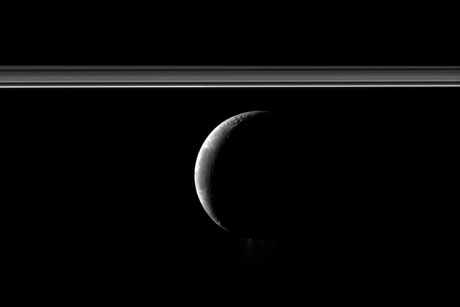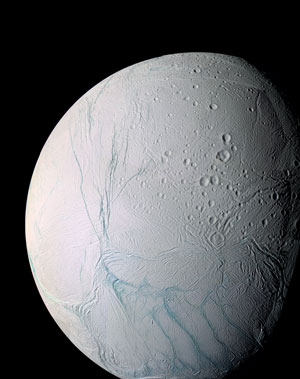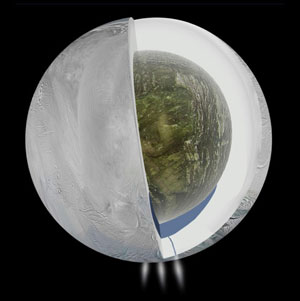Saturn moon reveals a cosmic, crust-covered sea
By Blaine Friedlander

A small moon of Saturn divulges something splashy: The thick, icy, crusty surface of Enceladus conceals a deep briny sea – made of water – with enough warmth and minerals to possibly nurture life, according to a new study published in the April 4 issue of Science.
Thanks to NASA’s Cassini Mission flybys between 2010 and 2012, scientists from Sapienza University of Rome, the Jet Propulsion Laboratory, the California Institute of Technology and Cornell have gravitational evidence to confirm the existence of a subsurface sea.
“For years we’ve seen water vapor and geysers on Enceladus,” said Jonathan Lunine, Cornell’s David C. Duncan Professor of Physical Sciences and a member of the team. “With our knowledge of the moon’s shape and calculating the results of radio measurements, we have gathered enough evidence to convincingly show the existence of a sub-crustal sea. The vapor and the geysers occur for a reason and now we believe that they materialize because of that sea.”


Discovered 225 years ago by noted English astronomer and composer William Herschel, Enceladus is the sixth largest of Saturn’s 62 known moons. For more than two centuries, little was known about it until Cassini’s first flyby in 2005.
Its diameter measures 310 miles, while the moon’s regional sea (the size of Lake Superior), in the southern hemisphere, lies beneath an icy, 20-mile shell. The water depth measures about 6 miles, similar to the Earth’s Marianas Trench in the Pacific Ocean.
What makes this sea intriguing to astrobiologists, explains Lunine, is that the body of water sits on a rocky surface, allowing minerals to interact with the liquid water and produce ingredients for life.
Unlike the Earth, where radioactive decay is largely responsible for the energy driving geology, the activity on the moon Enceladus is likely caused externally by the large planet Saturn in a process called “tidal heating.” Think of Saturn as kneading, grinding and pulling the misshapen Enceladus through different magnitudes of gravitational forces. The ocean may be sustained by this tidal heating, according to the scientists.
No fictional comic book X-ray glasses were used to find the water. Instead, the scientists relied on Doppler radio signatures, observed with the Earth-based NASA Deep Space Network, from 746 million miles away.
The NASA network listened to the signal transmitted by the Cassini spacecraft as it traveled through Enceladus’ space. Tiny changes in the frequency of the radio signal revealed subtle differences in the speed of the spacecraft under the influence of the gravity of Enceladus. These differences revealed variations in the density of the moon’s interior – leading scientists to find the sea.

Lead authors of the study, “The Gravity Field and Interior Structure of Enceladus,” are Luciano Iess and Marizia Parisi of Sapienza University of Rome; David Stevenson of CalTech; and Sami Asmar of Jet Propulsion Lab. In addition to Lunine, other scientists on the paper include: Doug Hemingway and Francis Nimmo, University of California, Santa Cruz; Robert A. Jacobson and John W. Armstrong, Jet Propulsion Laboratory; Marco Ducci, Sapienza, University of Rome; and Paolo Tortora, University of Bologna.
Media Contact
Get Cornell news delivered right to your inbox.
Subscribe